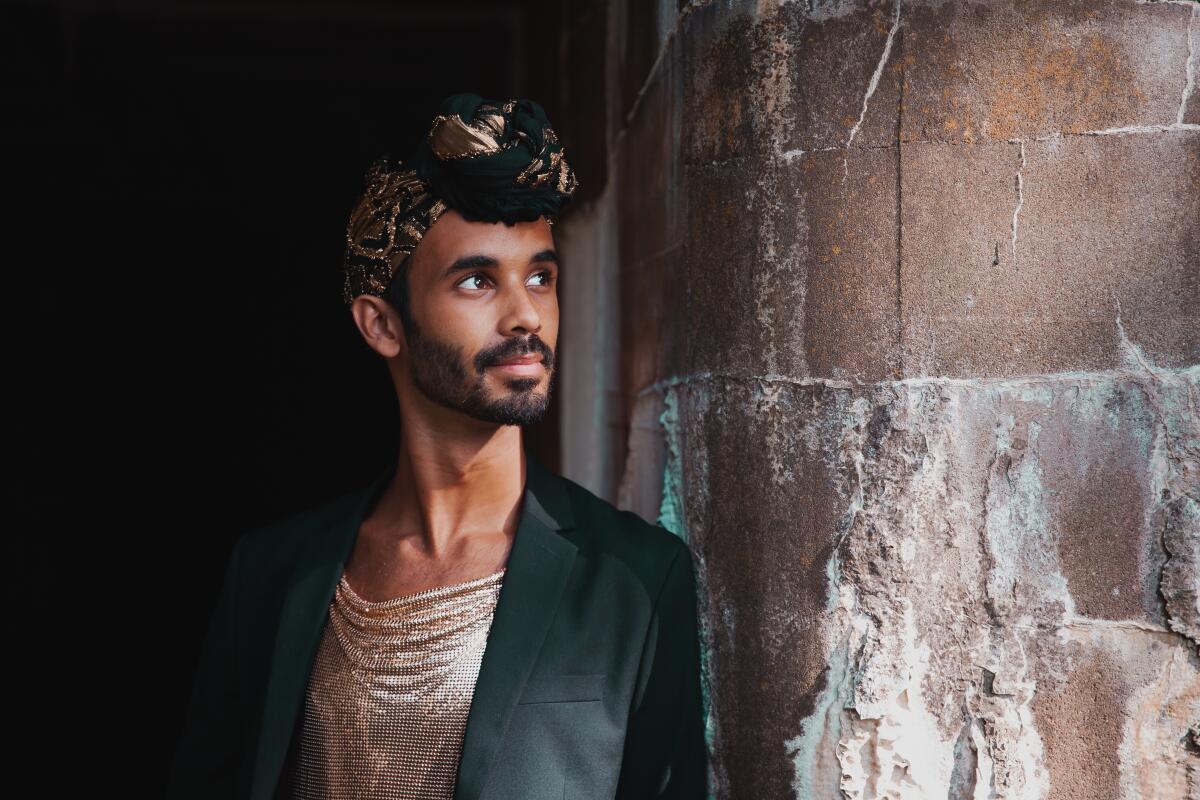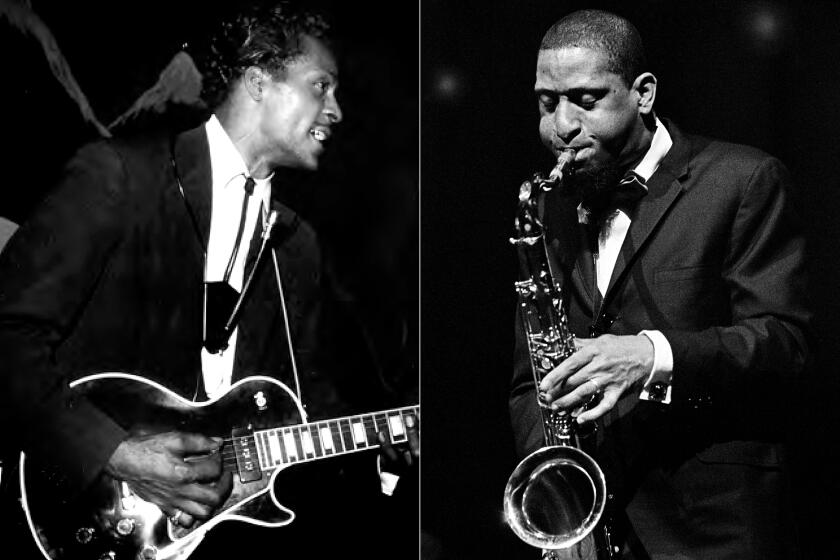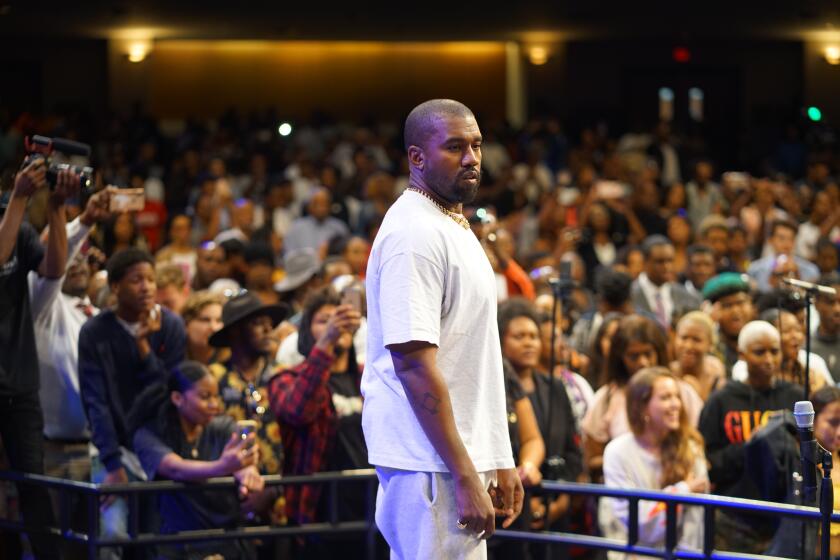Jake Blount unearths Black history through folk music, using its sounds as a bridge to the future

- Share via
The first show Jake Blount ever played professionally was at a furniture maker’s workshop in Hillsborough, N.C. Blount, who specializes in performing Black American traditional music, played a set of folk tunes that included the blues standard “John Henry.” Between songs, he talked about the music’s context within the legacies of slavery and the U.S. prison system. “I did what I felt was a pretty transgressive reading of the songs,” Blount said of that show. “I was pushing in the way that I presented this stuff.”
After the show, a white woman approached him and, as Blount recalls it, said that it was good to see “a young Black person learning from the older generations,” because “today’s Black people are just too angry.” Blount was floored.
“That is the exact opposite of what I just tried to do,” he said, remembering his reaction. “I just tried to play this music and explain how it relates to the history of oppression and suffering — and yes, anger and resentment — that have always been a part of the Black experience in this country, and you just ignored all of it.”
Blount recounts this story with good-natured disbelief on a video call from his hotel room between classes he was teaching at a fiddle camp earlier this month in Westford, Mass. — an ostensible break from touring in support of his new record, “The New Faith,” released in September by Smithsonian Folkways. On Saturday, Blount concludes a four-day stretch of dates in California with a show at the Hotel Café in Hollywood.
“The New Faith,” co-produced by Blount and Brian Slattery, is an Afrofuturist concept album set after civilization’s collapse under climate change, built of what Blount calls “radical arrangements of traditional songs.” Imagining a religious ceremony performed by a group of Black climate refugees on an island off the coast of Maine, the album features rearrangements of songs whose sources include Sister Rosetta Tharpe, Fannie Lou Hamer, Blind Willie McTell, and enslaved individuals whose names have been erased from the historical record; the earliest piece the album draws from dates to 1688.
Blount (pronounced blunt) recorded most of the album from his bedroom studio in Providence, R.I., where he’d moved just a month before the nationwide COVID-19 lockdown. Smithsonian Folkways approached him about an album that summer, when he was recovering from long COVID and shortly after the murder of George Floyd — a time when he felt “stricken by the sudden concreteness of my own mortality and the collapse of everyday life.”

Examining his repertoire, Blount writes, he asked himself two questions: “What will this music sound like when I’m dead? What will this music sound like when everyone is dead?” “The New Faith” offers answers to those questions that are both speculative and, in 2022, feel quite plausible.
Absurdly talented in about every way a musician can be, the 27-year-old Blount is a virtuosic multi-instrumentalist (primarily banjo and fiddle), with a hauntingly gorgeous voice and a bottomless, scholarly knowledge of American musical history. His concerts are often sprinkled with facts from the past, which he dispenses with offhand charm between songs. “The New Faith” uncovers Black American folk songs from beneath centuries of white canonical snowdrifts — a task he says can feel frustratingly perpetual as that snow keeps falling.
During our conversation, after recounting the exchange at the Hillsborough furniture shop, Blount pointed to another fresh example of this: a recent write-up of a track from “The New Faith,” “Death Have Mercy,” mistakenly attributed its source to the white Appalachian preacher and folk musician Lloyd Chandler. In fact (and as the album’s liner notes indicate), the track is a recording of a song that Black musicians have been documented singing as early as 1908 — when Chandler was 12 years old — and from which he derived his more famous “A Conversation With Death.”
For Blount, these sorts of mistakes — perhaps especially unintentional ones — are why he feels duty-bound not just to keep the folk traditions he’s inherited alive, but also to correct and clarify the historical record surrounding them.
“If I just play the songs and take the attitude that I don’t need to explain anything else, just out of laziness a lot of people are going to wind up retelling the same warped and distorted and revised histories,” Blount said. “That’s a big part of my thought process. How can I welcome in other people like me who don’t know that this belongs to them?”
Blount grew up in Washington, D.C., in the 1990s and the 2000s, when the city was a hotbed of musical influence with thriving go-go, punk and hardcore scenes. At age 12, he started playing the electric guitar, and in his teens “did the high school rock band thing.” But a fateful encounter with the musical duo Megan Jean and the KFB at an Ethiopian restaurant on U Street set Blount on a different musical path. After the band’s set that evening, he approached band member Byrne Klay, who’d been playing the clawhammer banjo.
“He explained to me that the banjo was descended from African instruments and had taken its current form in the hands of enslaved Black people here in the Americas,” Blount said. “I had no idea prior to that. Although he wasn’t playing old-time stuff, he definitely sent me down that road.”
When he enrolled at Hamilton College in 2013, Blount started studying the banjo with the musicologist Lydia Hamessley, and a year later took up the fiddle. Bolstered by earnest dedication and hours of practice, Blount proved a quick study of the challenging instrument. “It intuitively fell into my hands in a way nothing else has,” Blount said of the banjo.

Once, in a conference with Hamessley, they discussed how the banjo had its first explosion of growth in the United States among enslaved Black people in the Chesapeake Bay. Blount’s father, who is Black, is from that region, and that side of Blount’s family has been there for generations. “I mentioned that, and she said, ‘Well, it’s in your blood,’” Blount said.
After graduating, Blount moved to Ithaca, N.Y., to shore up his college thesis, where he contemplated graduate school and started playing gigs around the Northeast — and quickly realized he was booking enough to make playing music his full-time job. His debut EP, “Reparations” (2017), was followed three years later by a deservedly acclaimed solo album, “Spider Tales.”
Blount’s performances of traditional songs have always been marked by the way they both collapse and expand time, bringing an urgent immediacy to tunes that are decades and even centuries old. “The New Faith” seems to complete the temporal hat trick by bringing the music into the future.
In doing so, Blount certainly makes a successful case for these songs’ endurance. But the venture of projecting an album into the future — especially one centered on climate catastrophe — can face its own set of preconceived expectations that can lead to misconstruction.
“I get reviews that say things like, ‘The album rings with hope and resilience,’ and I’m like, ‘Where?’” Blount said, laughing. “I think people come to an album about climate change with an idea that it must be inherently solutions-oriented, that this is protest music. More power to people who are doing that, but I did this to explore my best guess for what’s coming. It’s not intended to be that imaginative.”
It’s indeed difficult to understand how an album containing spoken interludes (three in total, all written by Blount) composed of lines like “The seeds of avarice germinate in time within every generation” could be construed as a particularly hopeful one. Blount points to Octavia Butler’s 1993 classic climate fiction novel “Parable of the Sower” as a major influence on the record. In that book, Blount says, Butler was “just seeing what this is like for people.”
“I’m not trying to force optimism on this situation,” he said of his own imagined futurist narrative. “I’m just trying to explore it as it is.”

Besides the futurist narrative unifying the album, a few musical motifs bind together the wide-ranging songs that make up “The New Faith.” One of these is contextually rich interjections by the rapper Demeanor (nephew of the Grammy and MacArthur-winning musician Rhiannon Giddens, whom Blount has studied under). Another is polyphonic clapping, a pillar of the Gullah Geechee musical tradition — a tradition, Blount writes in the liner notes, “whose contributions to the record of early Black folks music are unrivaled” and without which the album “could not have been made.”
Due to a combination of the album’s concept, the incomplete makeup of the Black musical-historical record, and Blount’s long having been drawn to what he calls “fire and brimstoney songs about death and dying,” many of the tracks on “The New Faith” have spiritual themes. But both within the album’s context and in and of themselves, Blount notes, the songs are free from religious orthodoxy.
Being queer, Blount says he’s never felt especially welcomed by the Christian church. But he points out that he barely had to change a word of songs on the album that have been frequently associated with Christian traditions — and that they fit seamlessly into the futurist, deliberately vague religious service that forms the album’s setting.
One of those songs, “Didn’t It Rain” — which has been performed by Sister Rosetta Tharpe and Mahalia Jackson — describes the kind of great, world-rocking flood perhaps most famously chronicled in the Book of Genesis, but which appears in even older narratives like the Babylonian Atra-Hasis and the Chinese Gun-Yu myth. One entry’s privilege in a historical record, as Blount tirelessly reminds his listeners, can obscure a wider and richer tapestry.
More to Read
The biggest entertainment stories
Get our big stories about Hollywood, film, television, music, arts, culture and more right in your inbox as soon as they publish.
You may occasionally receive promotional content from the Los Angeles Times.












